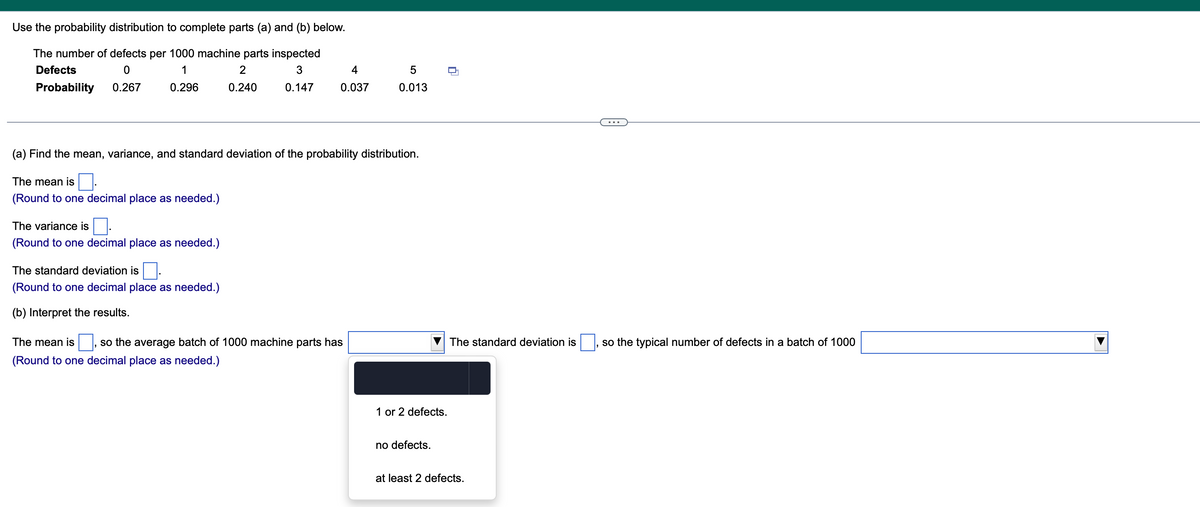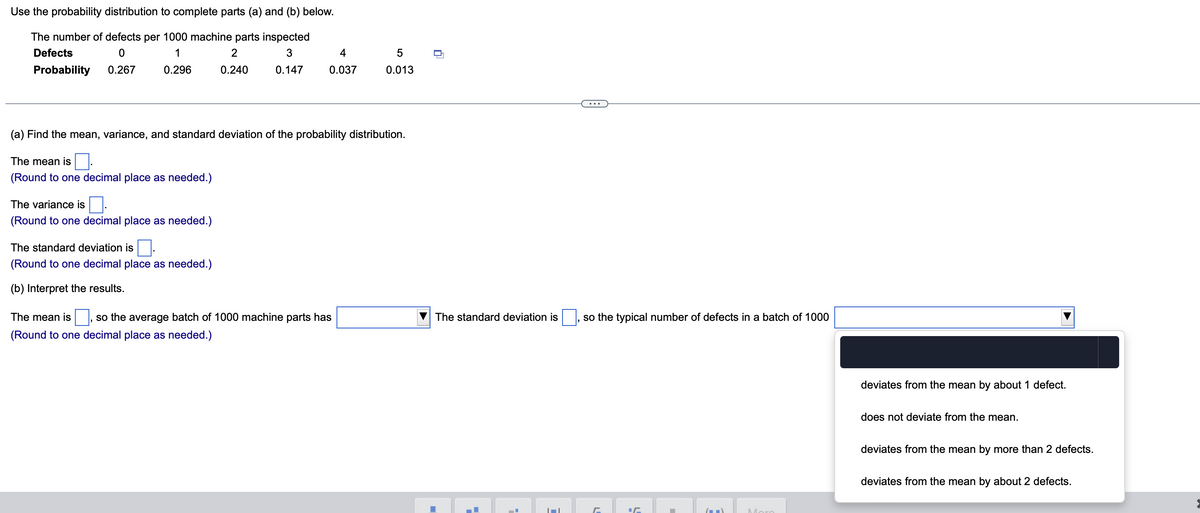Use the probability distribution t complete parts (a) and (b) below. The number of defects per 1000 machine parts inspected Defects 3 4 0 0.267 1 0.296 2 0.240 Probability 0.147 0.037 (a) Find the mean, variance, and standard deviation of the probability distribution. The mean is (Round to one decimal place as needed.) The variance is (Round to one decimal place as needed.) The standard deviation is. (Round to one decimal place as needed.) (b) Interpret the results. 5 0.013 The mean is, so the average batch of 1000 machine parts has (Round to one decimal place as needed.) D 1 or 2 defects. no defects. The standard deviation is at least 2 defects. ,so the typical number of defects in a batch of 1000
Use the probability distribution t complete parts (a) and (b) below. The number of defects per 1000 machine parts inspected Defects 3 4 0 0.267 1 0.296 2 0.240 Probability 0.147 0.037 (a) Find the mean, variance, and standard deviation of the probability distribution. The mean is (Round to one decimal place as needed.) The variance is (Round to one decimal place as needed.) The standard deviation is. (Round to one decimal place as needed.) (b) Interpret the results. 5 0.013 The mean is, so the average batch of 1000 machine parts has (Round to one decimal place as needed.) D 1 or 2 defects. no defects. The standard deviation is at least 2 defects. ,so the typical number of defects in a batch of 1000
A First Course in Probability (10th Edition)
10th Edition
ISBN:9780134753119
Author:Sheldon Ross
Publisher:Sheldon Ross
Chapter1: Combinatorial Analysis
Section: Chapter Questions
Problem 1.1P: a. How many different 7-place license plates are possible if the first 2 places are for letters and...
Related questions
Question
100%

Transcribed Image Text:Use the probability distribution to complete parts (a) and (b) below.
The number of defects per 1000 machine parts inspected
Defects
0
0.267
1
0.296
2
0.240
3
0.147
Probability
The variance is.
(Round to one decimal place as needed.)
4
0.037
(a) Find the mean, variance, and standard deviation of the probability distribution.
The mean is
(Round to one decimal place as needed.)
The standard deviation is
(Round to one decimal place as needed.)
(b) Interpret the results.
5
0.013
The mean is so the average batch of 1000 machine parts has
(Round to one decimal place as needed.)
1 or 2 defects.
no defects.
0
The standard deviation is
at least 2 defects.
so the typical number of defects in a batch of 1000

Transcribed Image Text:Use the probability distribution to complete parts (a) and (b) below.
The number of defects per 1000 machine parts inspected
Defects
3
0
0.267
1
0.296
2
0.240
Probability
0.147
The variance is
(Round to one decimal place as needed.)
4
0.037
(a) Find the mean, variance, and standard deviation of the probability distribution.
The mean is
(Round to one decimal place as needed.)
The standard deviation is
(Round to one decimal place as needed.)
(b) Interpret the results.
5
0.013
The mean is so the average batch of 1000 machine parts has
(Round to one decimal place as needed.)
0
The standard deviation is
■
-
ī
so the typical number of defects in a batch of 1000
L
G
()
Moro
deviates from the mean by about 1 defect.
does not deviate from the mean.
deviates from the mean by more than 2 defects.
deviates from the mean by about 2 defects.
Expert Solution
This question has been solved!
Explore an expertly crafted, step-by-step solution for a thorough understanding of key concepts.
Step by step
Solved in 2 steps with 2 images

Recommended textbooks for you

A First Course in Probability (10th Edition)
Probability
ISBN:
9780134753119
Author:
Sheldon Ross
Publisher:
PEARSON


A First Course in Probability (10th Edition)
Probability
ISBN:
9780134753119
Author:
Sheldon Ross
Publisher:
PEARSON
